SEO is a long-term, ongoing service with strategic importance for business success. It covers a range of activities that all require careful planning and coordination. As an SEO service provider, you probably know all this. However, do your clients know? Are you on the same page with every client regarding goals, expectations, timeline, and responsibilities?
That’s exactly why you need to talk to your new SEO clients upfront. The best way to do this is in the form of a questionnaire. Let’s explore the 27 essential SEO onboarding questions that will help you and your clients stay aligned.
Why every SEO project needs a clear starting point
Every client engagement benefits from a shared roadmap, and onboarding is what creates it in the first place. This initial session ensures both parties understand where they are now, where they want to go, and which resources will get them there.
Adapted from HR practices, onboarding in SEO frames the collaboration as a structured process. It can take the basic form of a conversation or a questionnaire disseminated by email or via an online survey tool.
Your SEO client questionnaire should span business objectives, audience segments, competitive landscape, and any technical hurdles hidden beneath the client site’s surface. You also establish how often performance reports land in the client’s inbox and which metrics matter most to decision‑makers.
By converting assumptions into documented agreements, you reduce miscommunication and keep momentum high. SEO onboarding questions for new clients reduce future friction by:
- Aligning strategy with revenue‑driving pages.
- Clarifying capacity for content and development tasks.
- Preventing scope creep through clear boundaries.
- Surfacing integration needs with other channels.
- Setting mutual expectations for response times.
A thorough starting point transforms a complex SEO journey into a guided path — clear, accountable, and much easier to follow. By making the onboarding session a part of your client acquisition process, you can establish a strong client pipeline and enjoy sustainable business growth.
1. Clarifying business goals
The main theme in the onboarding session should be business goals and objectives. Regardless of what you call it, the main idea is to understand the client’s business goals and see how you can help fulfill those with your SEO services.
Oftentimes, clients’ inspirations, challenges, and even values and mission also go under the business goals umbrella.
a. Setting realistic expectations for SEO impact
Many clients picture SEO as a magic catapult that launches them to page one overnight. In truth, organic growth is more like tending a garden: prepare the soil, plant seeds, and nurture results over weeks and months.
Your first job in onboarding is to paint that honest picture — no fairy dust, just a clear timeline of what’s possible and when.
Explain how Google needs time to crawl, recrawl, and reward improvements. Technical fixes can spark quick bumps, but authority‑building content and backlinks mature gradually. By grouping wins into short, mid, and long‑term milestones, you keep enthusiasm high without promising the impossible.
A candid expectations chat also helps align budgets, resources, and reporting cadence, so everyone tracks the same progress markers.
Here is a brief takeaway list for you on why expectation‑setting matters:
- Matches tactics to achievable timelines and resources.
- Keeps reporting focused on progress, not miracles.
- Builds trust through transparency and education.
- Prevents “Where’s my traffic?” panic at week three.
Ask your client the following questions (feel free to modify and use variations):
1. Which business milestones must SEO support within 3, 6, and 12 months?
2. What internal resources are available for content creation and technical fixes?
3. How frequently do you want progress updates, and in what format (e.g., dashboard, email, call)?
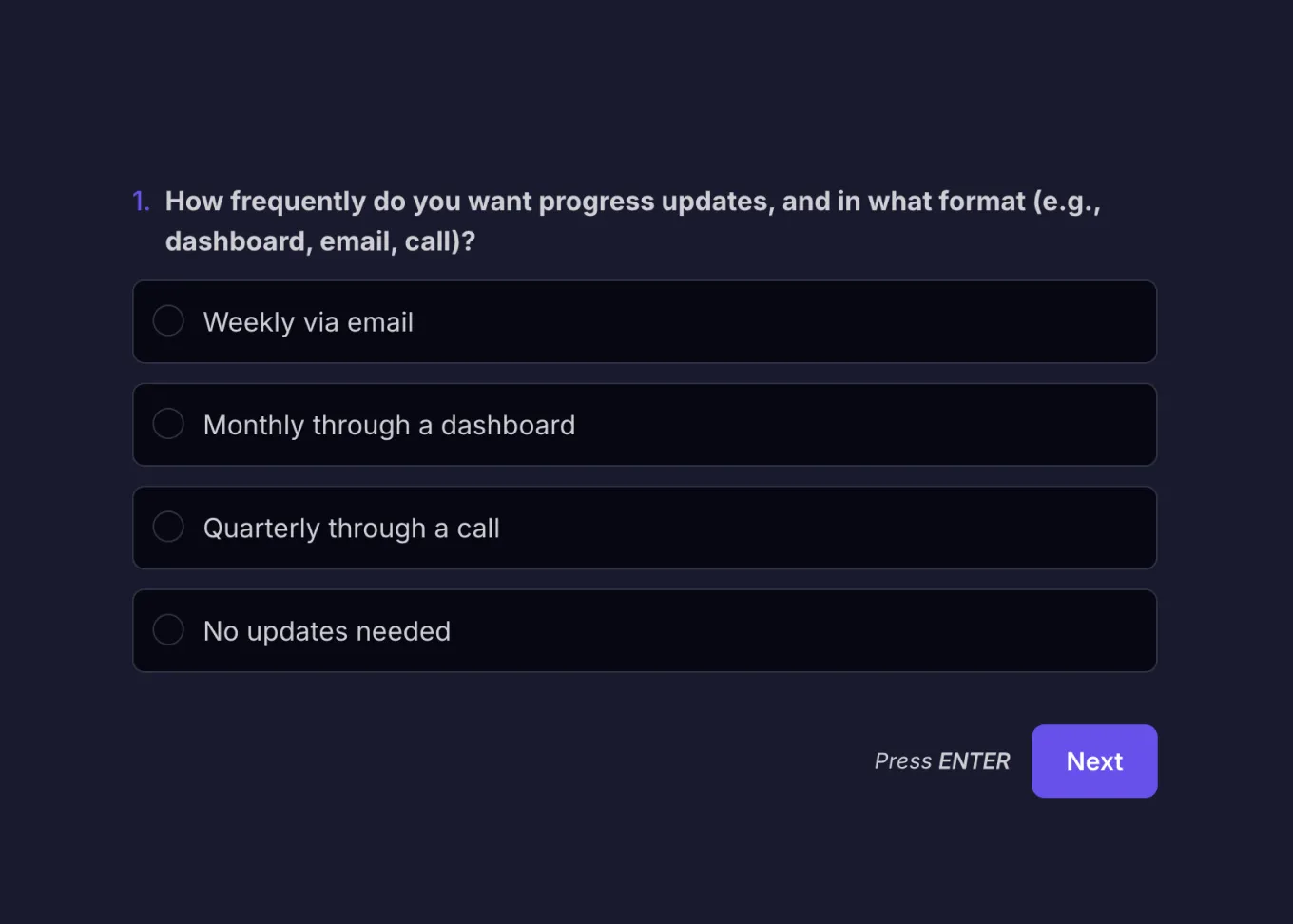
An example SEO question for setting a realistic expectation
b. Aligning SEO with business objectives
Start by mapping high‑intent search terms to revenue‑bearing pages. If a keyword doesn’t have a clear payoff — lead submission, add‑to‑cart, demo request — it may belong lower in the roadmap.
Next, marry brand goals (like thought leadership) to top‑funnel content that earns backlinks and media mentions.
Finally, layer in growth targets: local visibility to open a new region, or translation tweaks to capture an emerging market. When every tactic lines up with dollars, user counts, or brand mentions, your SEO plan stops feeling abstract and starts reading like a revenue forecast for your happy client.
Ask your client the following questions:
4. What revenue or growth targets do you need to hit this quarter (month, year)?
5. Which products or services yield the highest margin today?
6. Are there new geographic or industry markets you plan to enter that SEO should prioritize?
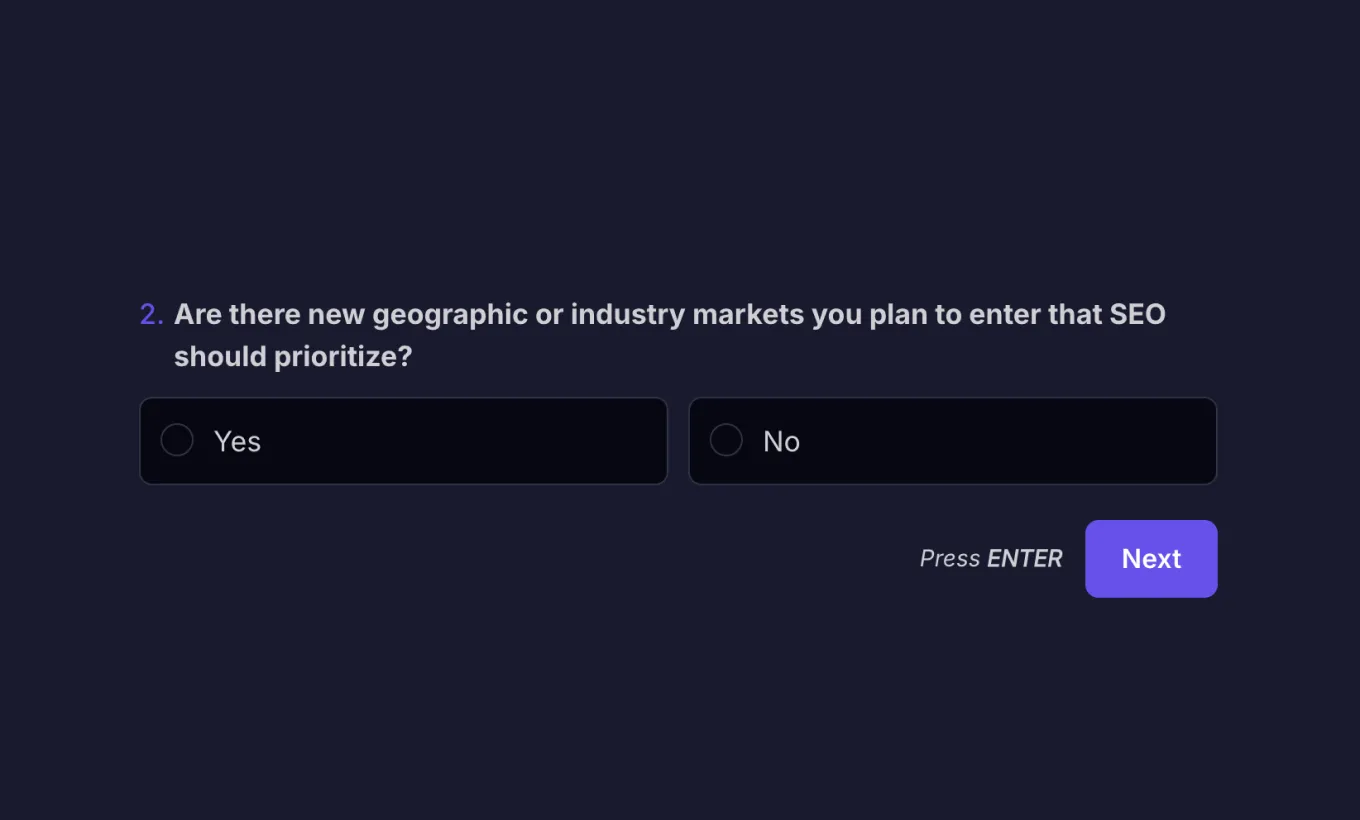
An example SEO question about a business objective
c. Key performance indicators (KPIs) and success metrics
KPIs are your campaign’s compass. Without them, even a spike in traffic can feel like wandering in the woods. Tie each metric to a clear outcome: traffic for awareness, conversions for revenue, and shares or mentions for brand strength. Pick just a handful that truly matter so reporting stays crisp and stakeholders stay awake.
Here is why KPI clarity pays off:
- Puts everyone on the same scoreboard.
- Flags red or green lights early.
- Turns reports into quick decision tools.
- Shows SEO’s impact in the language of profit.
Ready for the key takeaways? Here are some question ideas that you can ask your client:
7. What’s your top priority: traffic, conversions, or brand growth?
8. How do you define a “conversion” on your site?

An example SEO question for KPI
2. Understanding the target audience
Any SEO campaign is only as good as the clarity about the target audience. You don't want to optimize content for every possible customer, since it's costly, time-consuming, and inefficient.
Engaging in collaboration with your client, you must aim to understand their target audience, i.e., define their buyer persona, identify their pain points and needs, and segment the audience for better SEO efficacy.
a. Defining buyer personas
A buyer persona is a psychological and socio-economic portrait of the buyer. Oftentimes, one buyer persona is not enough, and an SEO campaign has to deal with several distinct buyer personas.
Once you have those personas sketched, the real work begins. Dig into analytics, interview sales and support teams, and comb through customer reviews. Each data point sharpens the picture:
- What keeps Persona A awake at 2 a.m.?
- Which features make Persona B hit “buy now”?
With that clarity, keyword research stops being a guessing game and turns into a matchmaking exercise — pairing their actual questions with the client’s most valuable pages.
Resist the urge to lump everyone together. Segment personas by funnel stage, buying power, or problem severity. Then craft content paths that speak to each segment in its own language.
When a B2B decision-maker lands on a page built for them — industry jargon, pain-point examples, and a solid case study — they’re far more likely to convert than if they’d stumbled into a generic and lengthy blog post.
This is what clear personas unlock for you as an SEO service provider:
- Laser-focused keyword clusters.
- Higher click-through and dwell time.
- Content that feels “written just for me.”
- Fewer wasted ad dollars (for you and your client).
With that information in mind, ask your client the following SEO onboarding questions:
9. Which customer type drives the bulk of your revenue today?
10. What pain points make that persona start searching online?
11. Where do these personas usually research solutions — Google, LinkedIn, niche forums, trade shows?
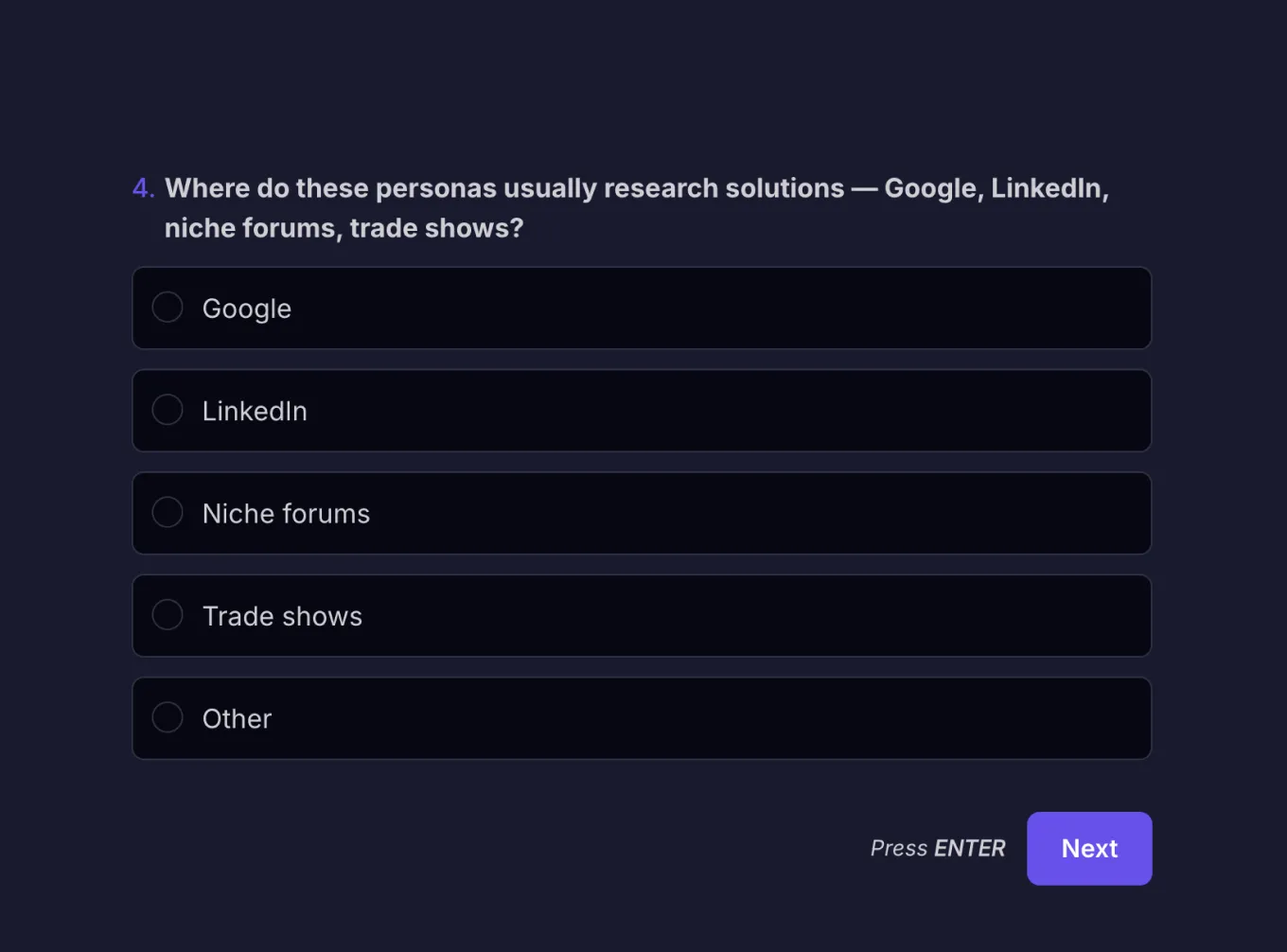
An example SEO question for defining buyer personas
b. Identifying pain points and needs
You don’t have X-ray vision, and the client’s Google Analytics won’t tell you why their CMO wakes up in a cold sweat. The only way to surface real pain points is to ask, and keep asking until the story behind the metrics appears.
Treat onboarding like a therapy session: guide the client with open-ended questions, listen for emotion in their answers, and dig deeper when you hear words like “frustrating,” “expensive,” or “bottleneck.”
Sometimes you need to push clients to explain how each irritation translates into must-have fixes: blazing load times, higher-quality leads, or rock-solid credibility. Once you lock onto that core ache, every SEO move feels surgical, not scattershot.
Insights that good open-ended questions about the target audience's pain points and needs reveal:
- Specific frustrations that keep the audience up at night.
- Costs (time, money, stress) that those frustrations impose on them.
- Situations or triggers that push them to search for a solution.
- Doubts or objections that stop them from acting sooner.
- Desired outcomes they would gladly pay to achieve.
Now that you understand the purpose and the process of asking a client about the pain points, it’s time to add some questions to your SEO questionnaire for clients. Here are a couple of ideas:
12. What problems do your customers most often mention when they first contact sales or support?
13. Which tasks do buyers find too time-consuming, costly, or difficult?
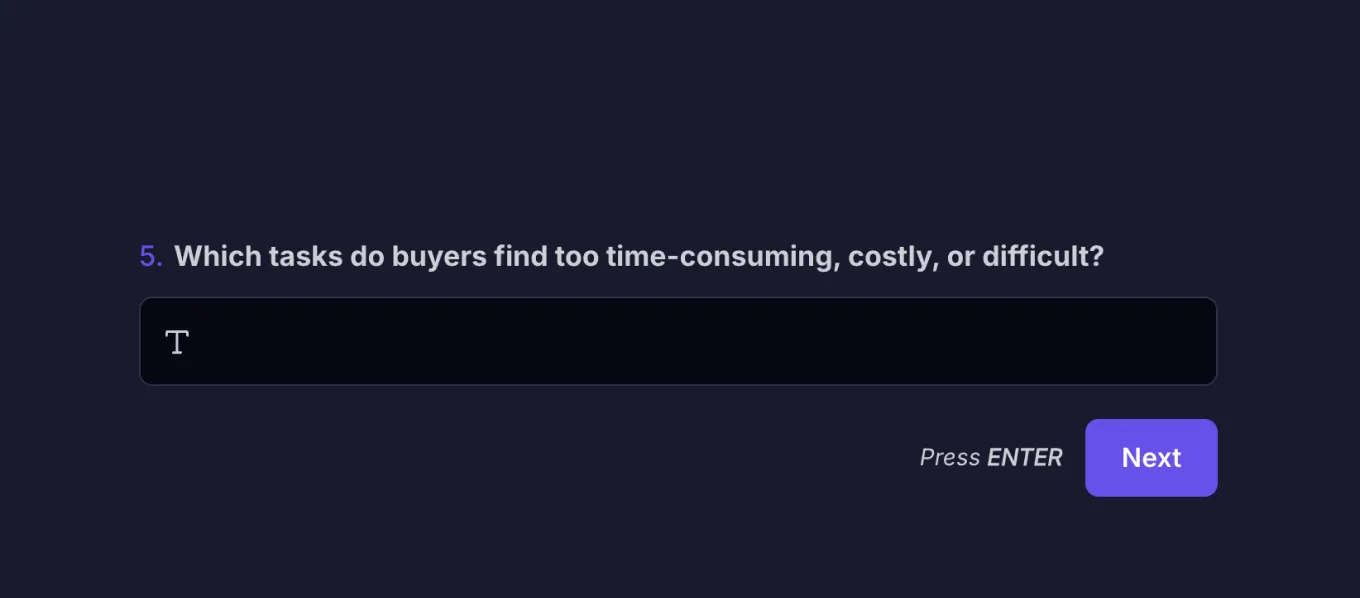
An example SEO question for identifying pain points & needs
c. Segmenting the audience for personalization
Once you know who the buyers are and what keeps them up at night, it’s time to split the crowd into neat little slices.
Not every visitor deserves the same blog post or the same keyword strategy. A C-suite decision-maker, a hands-on engineer, and a budget-minded student can all want your client’s product for wildly different reasons. Segmenting lets your client serve each persona exactly what they crave instead of offering everyone the same generic content.
Common segments to consider:
- Funnel stage (awareness, consideration, decision).
- Pain-point intensity (mild itch vs. five-alarm fire).
- Budget range or buying authority.
- Industry or vertical.
- Preferred content format.
You don’t need to ask your client any specific questions here, since all the inputs you’d need for segmentation have already been collected during the previous stages. It’s your battle this time. Nevertheless, it would still be a good idea to confirm with the client that the segments you’ve made are correct, and you are both on the same page here.
3. Understanding the client’s SEO needs & objectives
It’s time to formulate the essence — the needs, goals, and objectives for the SEO collaboration as such. Of course, you can have your own assumptions based on the earlier information about the client’s business goals and their customer personas. However, your new SEO client can always give you more information, and either confirm or refute your assumptions.
The primary goals of this dialogue should be understanding the as-is and identifying the to-be SEO state, including key attributes like targeted keywords and link-building strategy. You will ideally need to apply all your soft and hard SEO skills to pull this off.
a. Assessing the client’s current SEO
Much depends on the current SEO state of your client, as this is your starting point. If the client’s SEO is in good shape and already bringing great results, then your role in this might be more of a high-level consultant, refining and fine-tuning what works for even better efficiency.
On the contrary, if the client’s SEO deserves to be much better, or if it’s barely on the radar at all, you’ll need a full triage plan. The quickest way to gauge which scenario you’re walking into is to ask targeted, numbers-oriented questions that reveal both wins and wounds, without forcing the client to dig through endless spreadsheets on the first call.
Start with traffic health — steady climb or slow leak? Tie those visits to cash: which pages convert and which just lurk. Then scan for tech problems; one rogue plugin can sink months of SEO work.
Use short, direct questions to keep the conversation efficient:
14. Which three pages drive most of your organic revenue right now?
15. What tools do you currently use to track rankings and site health?
16. Are there technical issues (slow load times, crawl errors) you’re already aware of?
17. Which competitors consistently outrank you for money?
Collecting these answers turns a vague “we want better SEO” into a data-backed starting line, letting you prioritize quick fixes or advanced strategies with confidence.

An example question for assessing the client’s current SEO
b. Identifying primary SEO objectives
SEO can be very broad and overwhelming without a specific focus. To avoid extra work and spending (for both you and your client), ask your client about their SEO objectives.
Even before any audits or keyword maps, ask the client what a “win” looks like in your onboarding meeting. Do they crave brand visibility, a steady flow of demo requests, or a revenue bump from existing pages? Sorting those priorities early saves budget and stops you from polishing pages no one cares about.
Keep the conversation tight by ranking goals against timelines and business impact. If cash flow needs help now, hunt quick-conversion keywords. If market expansion is the mission, build authority content first. Each tactic should serve one clear objective, not a wish list.
Onboarding SEO questions to ask to uncover true objectives:
18. Which metric — traffic, leads, or sales — keeps leadership up at night?
19. Are you launching new products or markets that need SEO support first?
20. What timelines do investors or execs expect for visible results?
21. If we could improve only one SEO metric this quarter, which one matters most?

An example question for identifying primary SEO objectives
c. Keyword research and targeting goals
Big-volume keywords look tempting, but they’re pointless if they don’t feed the client’s primary objectives. Start by asking which phrases already drive revenue or brand chatter. Then map each keyword idea to a funnel stage: awareness, consideration, or decision. This ensures every search term moves prospects toward the right goal.
What else can you do? Many things. For instance, measure difficulty against intent. For immediate revenue, bypass heavyweight keywords and lock onto long-tail, “wallet-open” searches. To raise authority, pursue expansive topics that naturally earn backlinks and press.
When keywords serve specific goals, campaigns run more smoothly and monthly reports practically write themselves.
Onboarding questions to nail keyword priorities:
22. Which search terms already bring in your best-quality leads?
23. Are there “must-win” keywords tied to upcoming product launches?
24. Which industry-specific keywords or phrases are your competitors ranking for that you find most aspirational or would like to target?
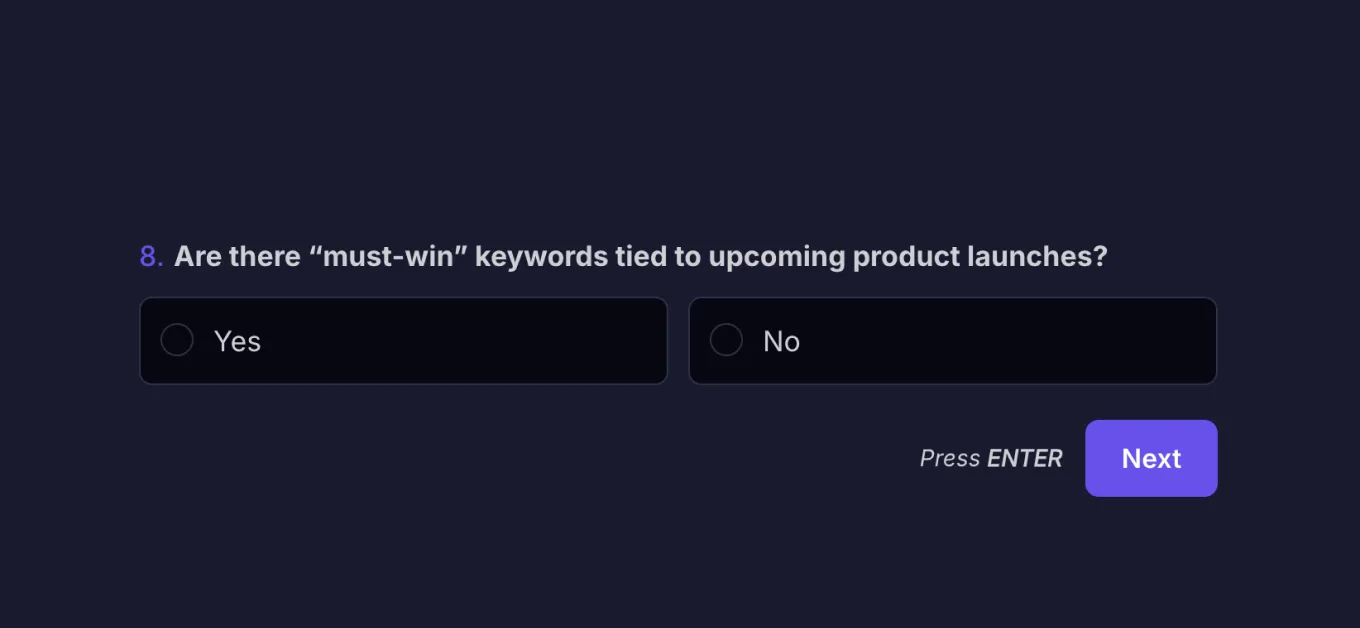
An example SEO question for keyword research & targeting goals
d. Link building and backlink strategy
Doing SEO consulting, you cannot avoid link building and backlink strategy development. Backlinks are like small but significant portals that transfer value (link equity, or “juice”) to and from the client’s web pages. They are important signals of trust for search engines that help drive targeted traffic and increase conversions.
A killer backlink profile isn’t a numbers game; it’s strategic matchmaking. Before outreach, find out where the client’s audience actually hangs out — industry blogs, podcasts, or academic journals. Aligning link targets with those hotspots keeps authority high and spam flags low.
SEO onboarding questions:
25. Which publications or influencers already resonate with your buyers?
26. Do you prefer guest posts, resource links, or digital PR mentions?
27. What metrics (e.g., referral traffic, DA, or rankings) should we track first?
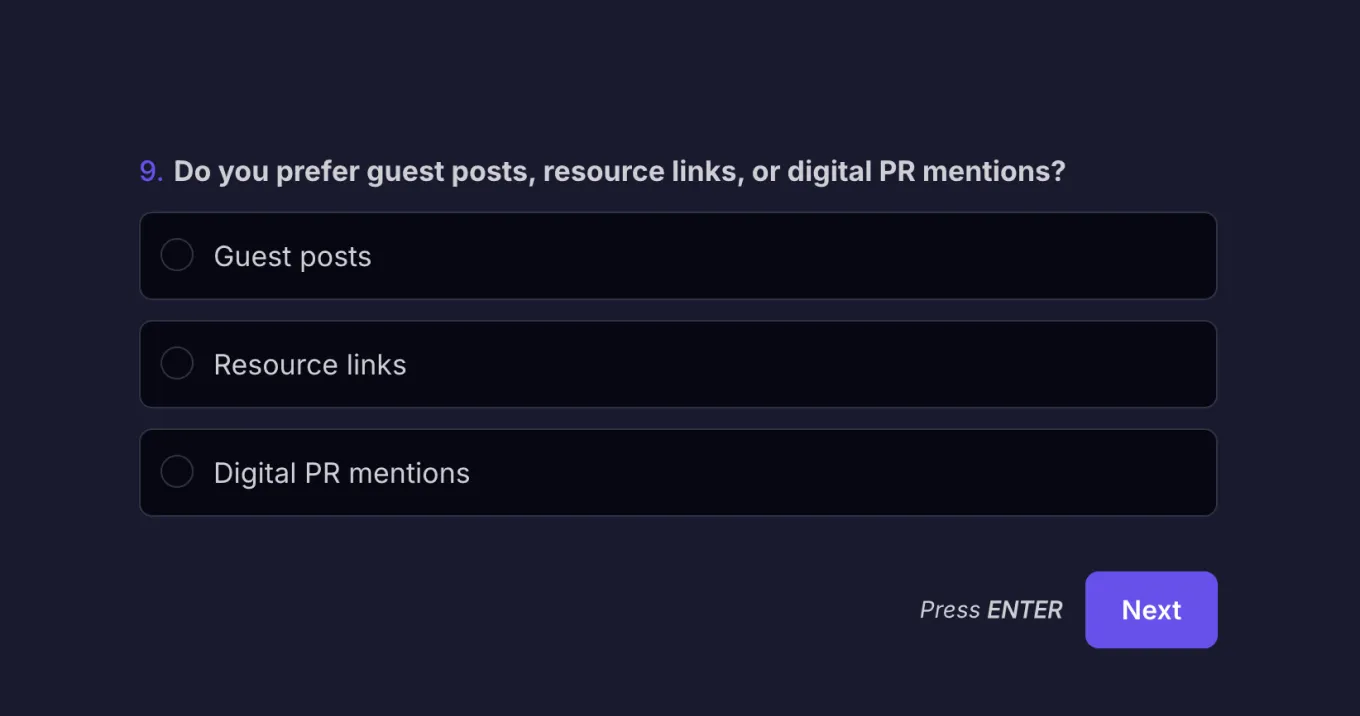
An example SEO question for link building and backlink strategy
How to create an onboarding survey for free
As a marketing service provider, you must value speed and convenience. It means no manual survey creation, setup, or conduct. Sure enough, you can take all the question suggestions mentioned in this article and copy-paste them (all of them or just the ones you find useful) into your survey.
However, that copy-paste moment should be the first and last manual task on your list. Everything else can be automated, and free of charge when utilizing the forms.app online survey constructor.
Follow these steps to create your first customer onboarding survey using forms.app:
1. Hit Create a form in the upper right corner of the home screen. From there, you’ll see a choice of options:
- Generate with AI
- Start from scratch
- Select a template
- Import a form
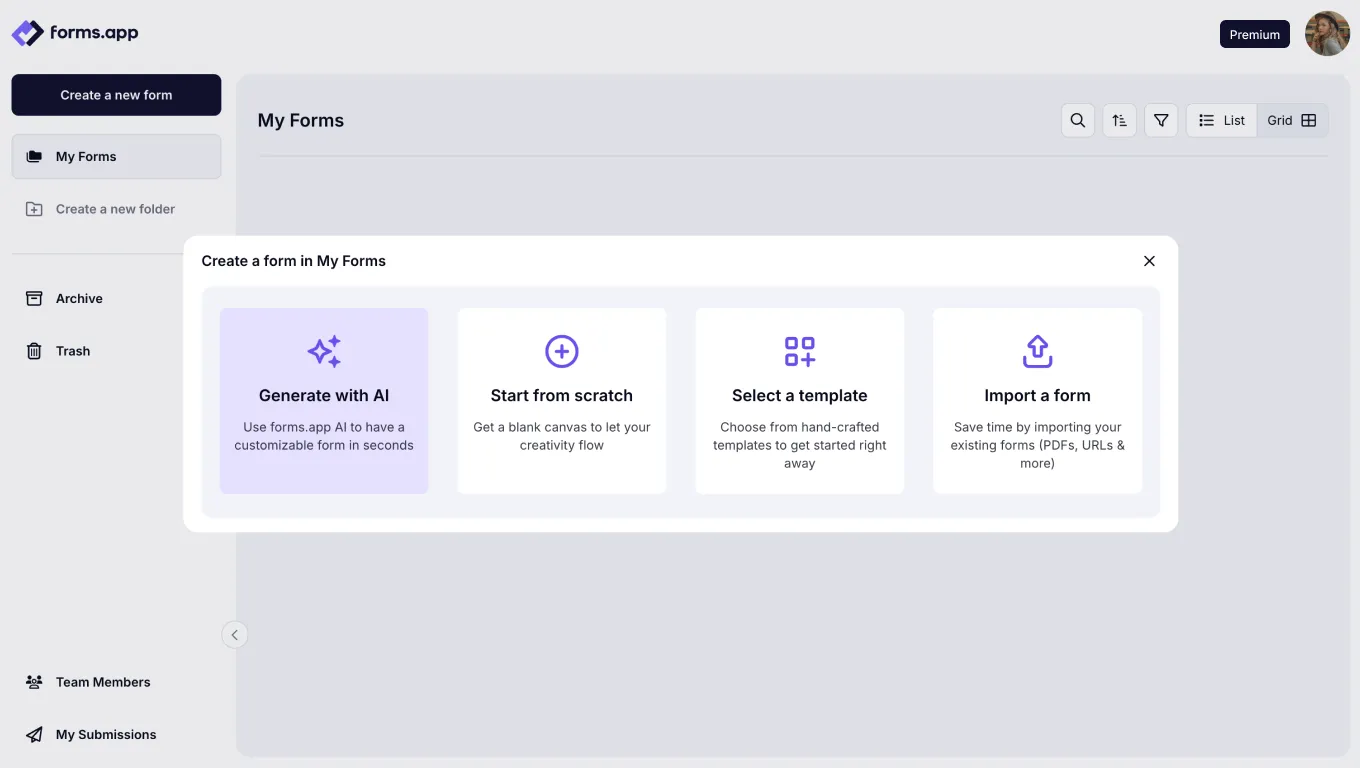
Choose a way to start
2. Let’s say you selected “Start from scratch” as you want to have full control over the process of building your custom survey.
3. Title your form, e.g., “New SEO customer onboarding survey.”
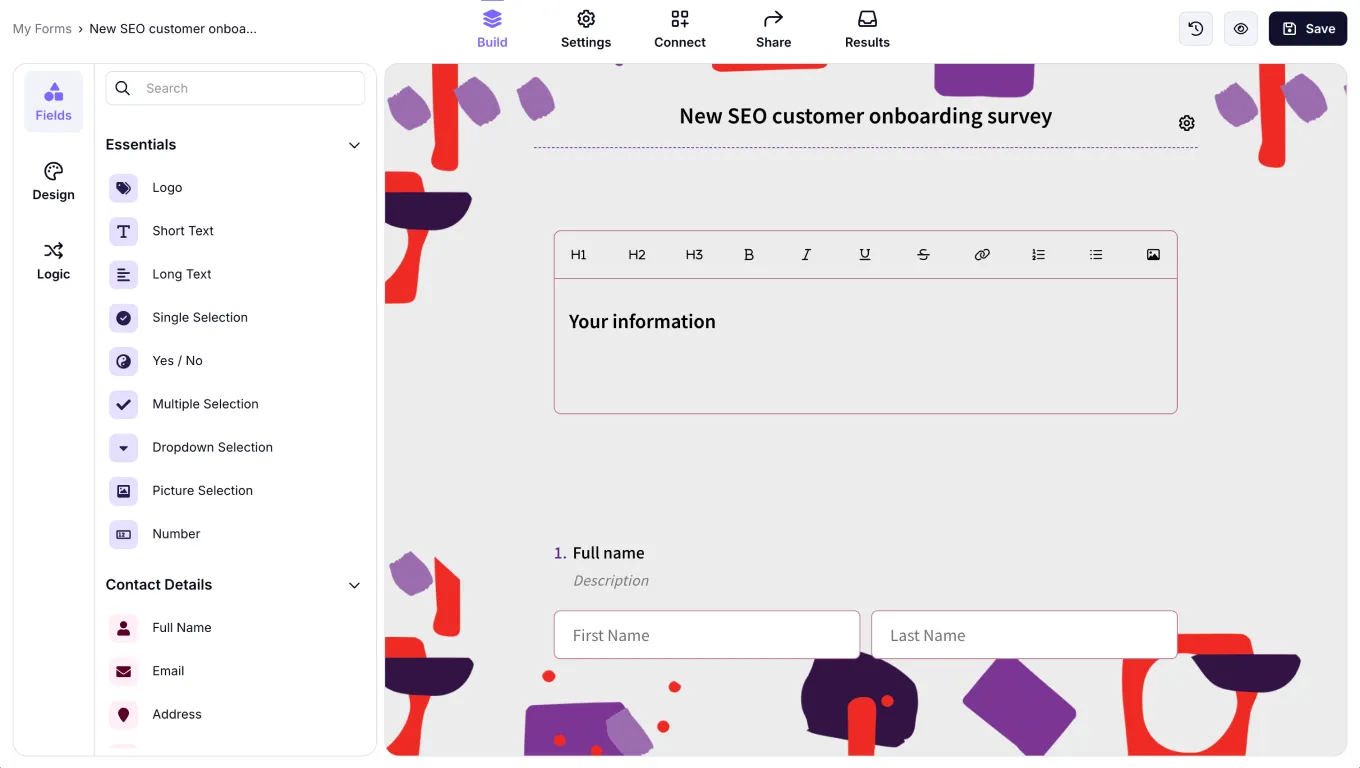
Title your survey
4. Choose whether you want several questions on a single page (List View) or each question to start on a new page (Step View).
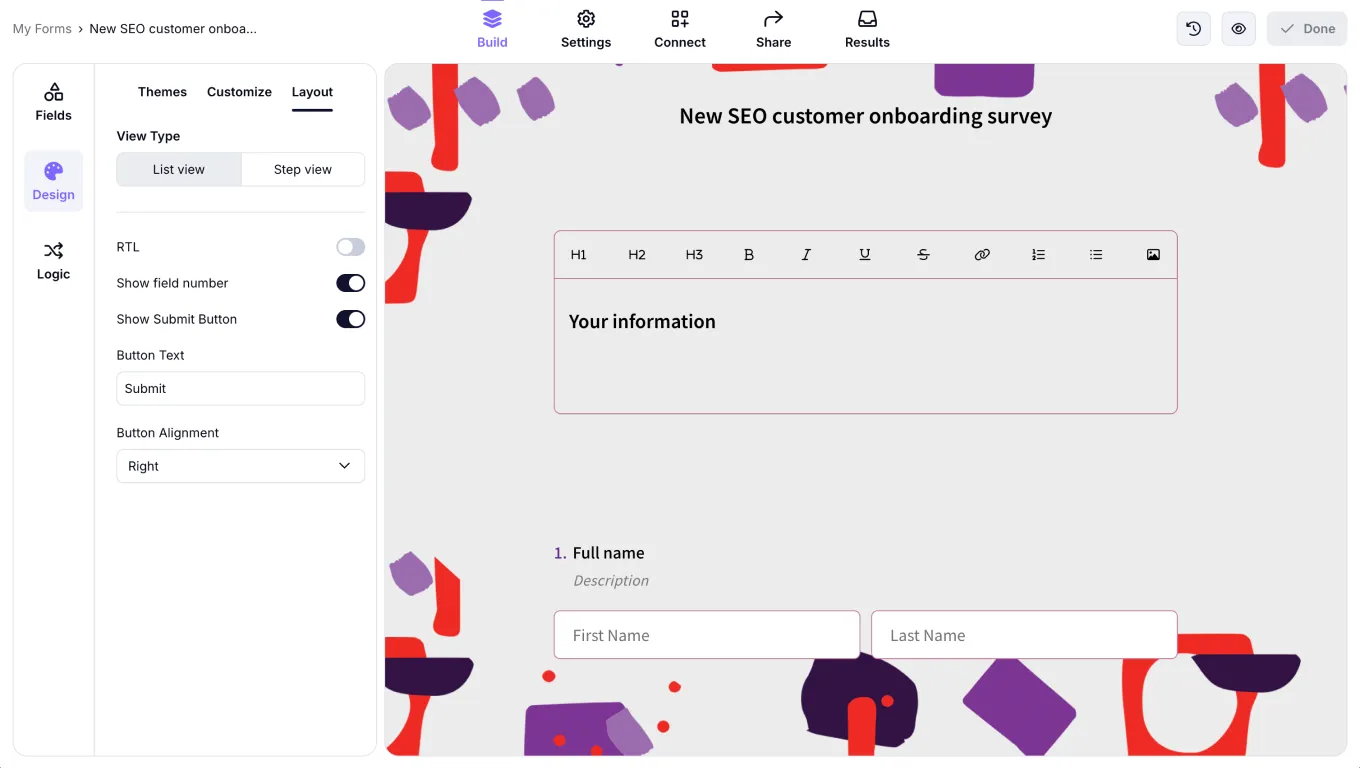
Choose a view option
5. Hit “Next”. From there, you’ll have three major customizable elements to complete:
- Fields containing essentials like logo, type of questions, whether they have pictures, etc.
- Design - select from the available templates and/or customize them to your liking.
- Logic, i.e., the flow of questions, whether the next should follow from the previous.
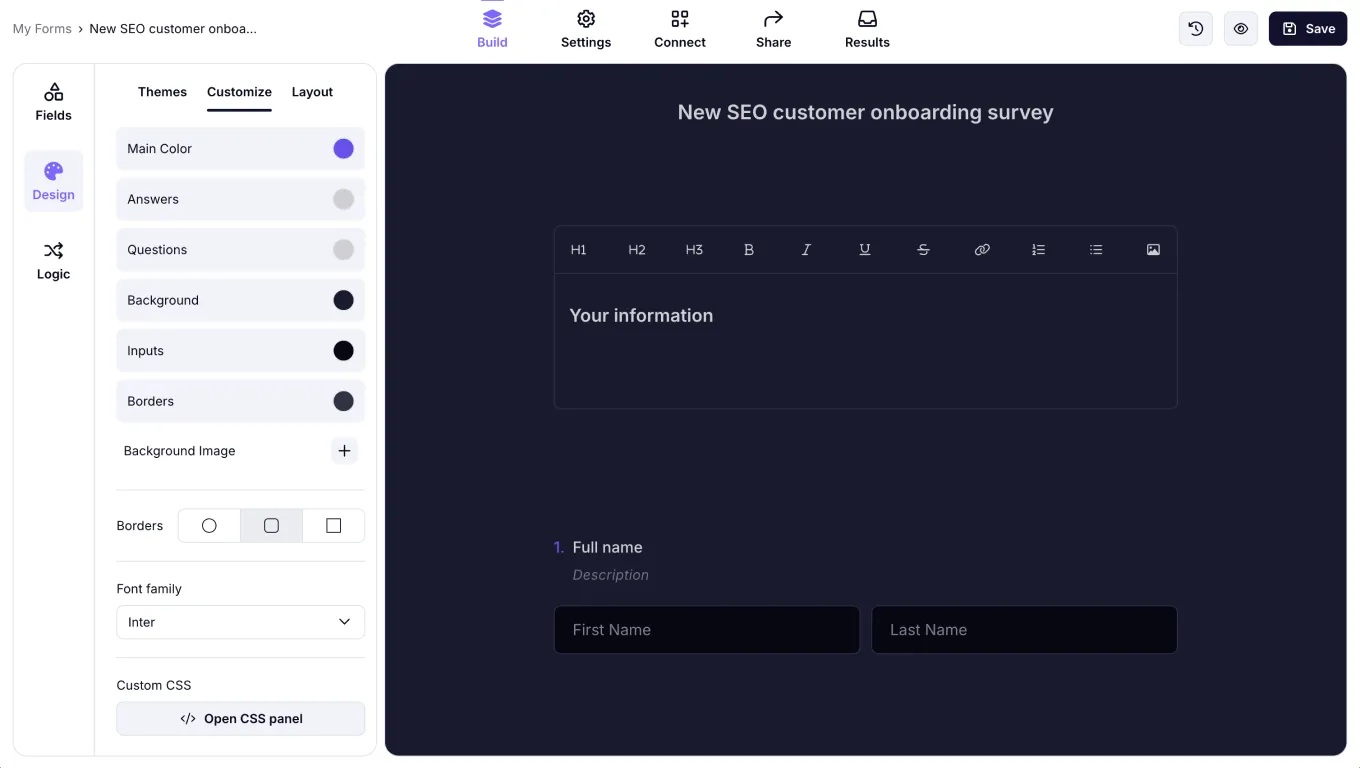
Add details & customize your survey
6. Once you’ve designed your custom survey, you can connect it to Google Docs, Slack, Mailchimp, or other platforms.
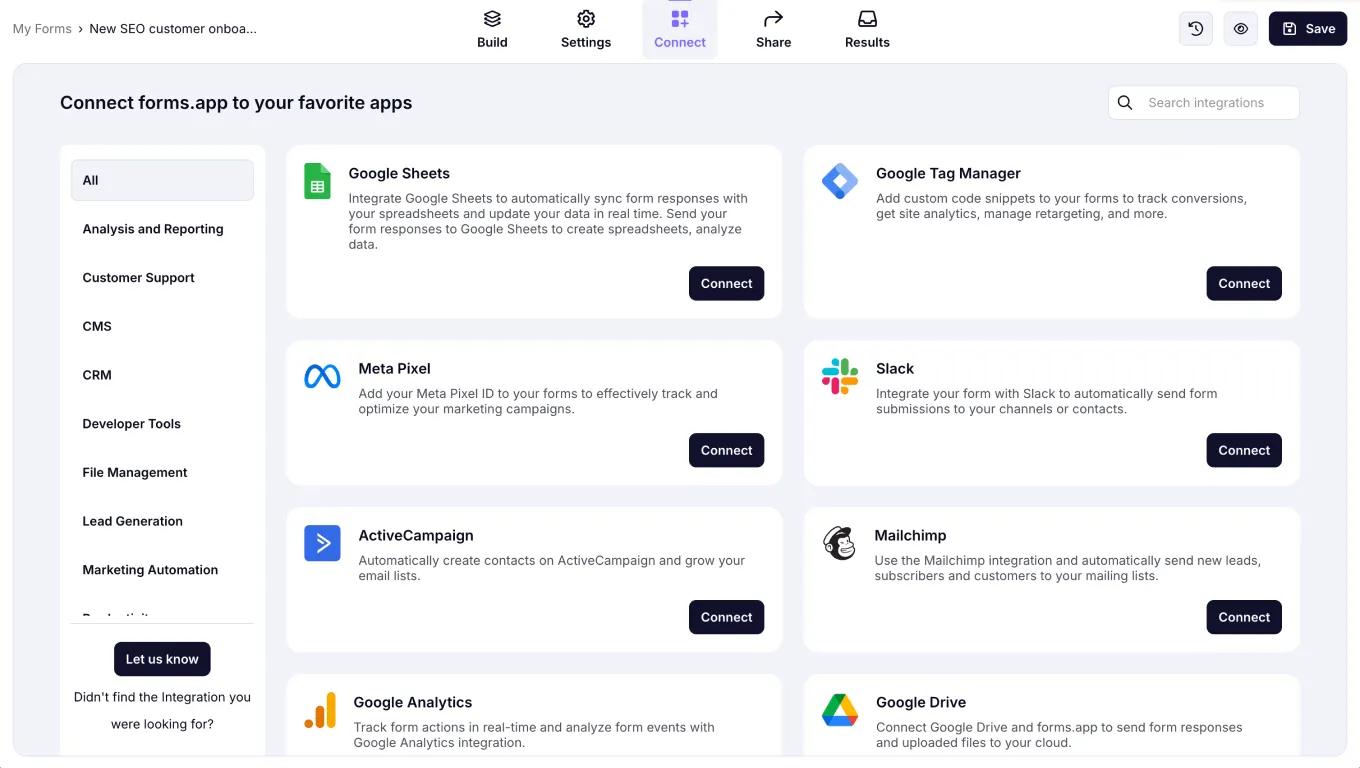
Connect your onboarding survey with other apps
7. Finally, you can run your survey, collect results automatically, and share them with your team members, respondents, or anyone you’d like (mind the privacy of answers).
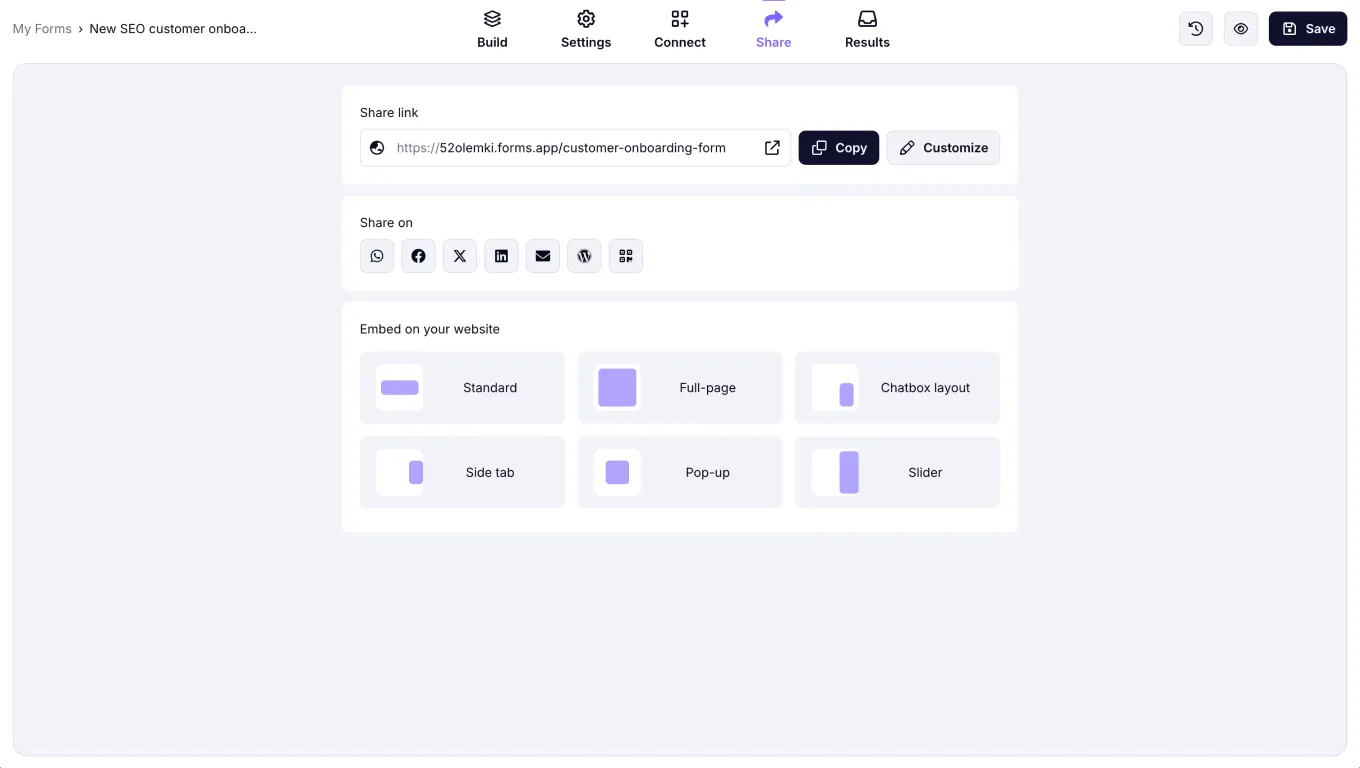
Share your survey
Conclusion
Every SEO client is unique and requires a custom approach, which can only be done through meticulously aligning goals and plans. In most cases, that alignment stipulates a physical or virtual kick-off meeting, also called onboarding.
For that onboarding meeting, you’d better come prepared and ask the right questions. Why? Because the second meeting may never happen (the client might reject you right away), or you may fail to deliver according to the client’s expectations (and that’s equally fatal for your collaboration).
The best approach that guarantees maximum results is to split the onboarding into two phases:
- Set up and conduct an online onboarding survey with your SEO client. You can use the free online survey app mentioned above. It will save yours and your client’s time and will enable you to look professional by coming fully prepared to the project kick-off meeting with the client.
- Run the kick-off meeting with your SEO client (whether physical or online). Use the answers and insights collected in the online survey phase to discuss the way forward. A good idea is to prepare a short presentation based on the survey findings and run it through your client to confirm and align your mutual priorities.
There’s no magic number of SEO onboarding questions for new clients — start with our comprehensive list of 27, cherry-pick what fits, and tailor each one to your project. Just ensure that every SEO area receives at least a couple of clear, purposeful questions.
forms.app, your free form builder
- Unlimited views
- Unlimited questions
- Unlimited notifications

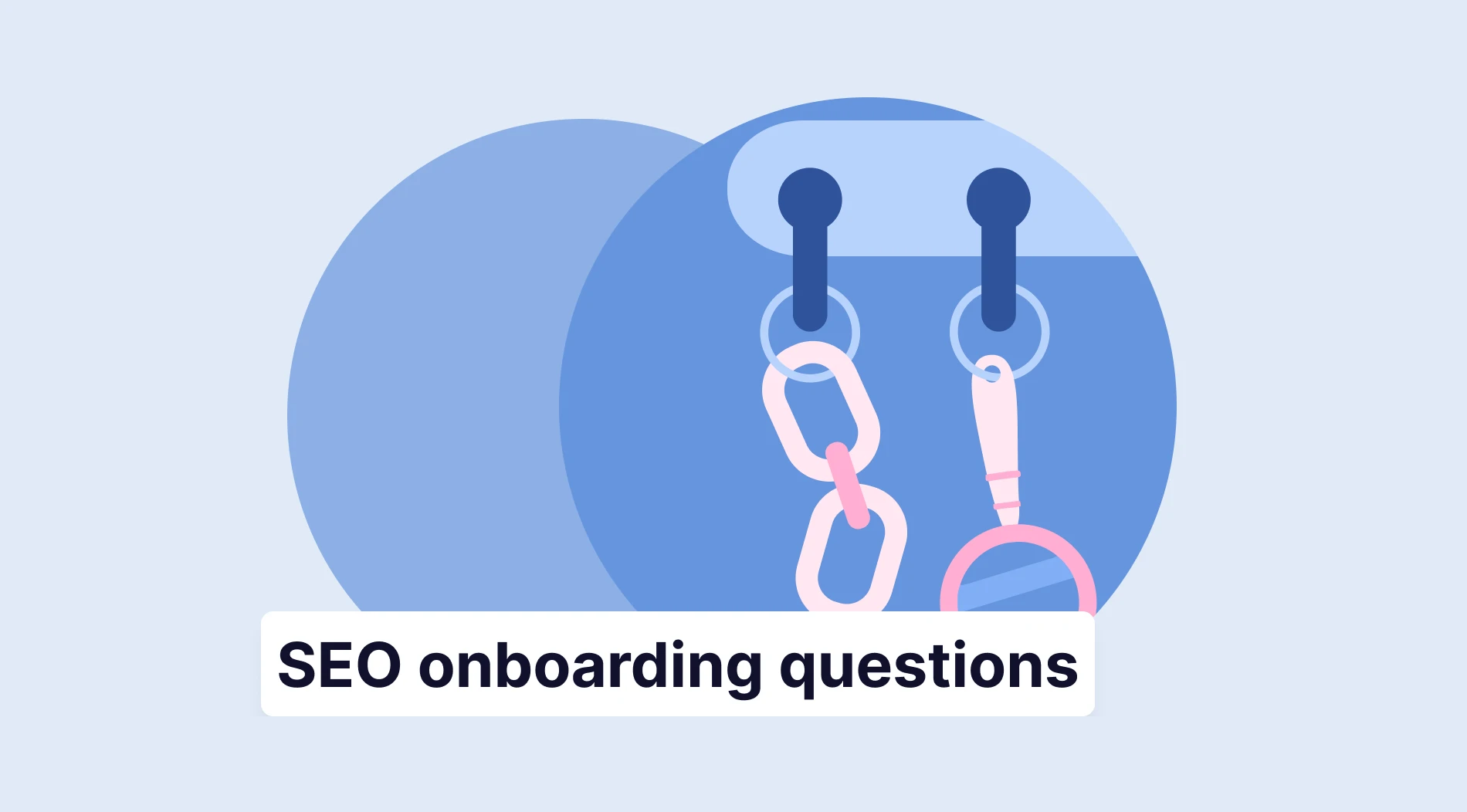
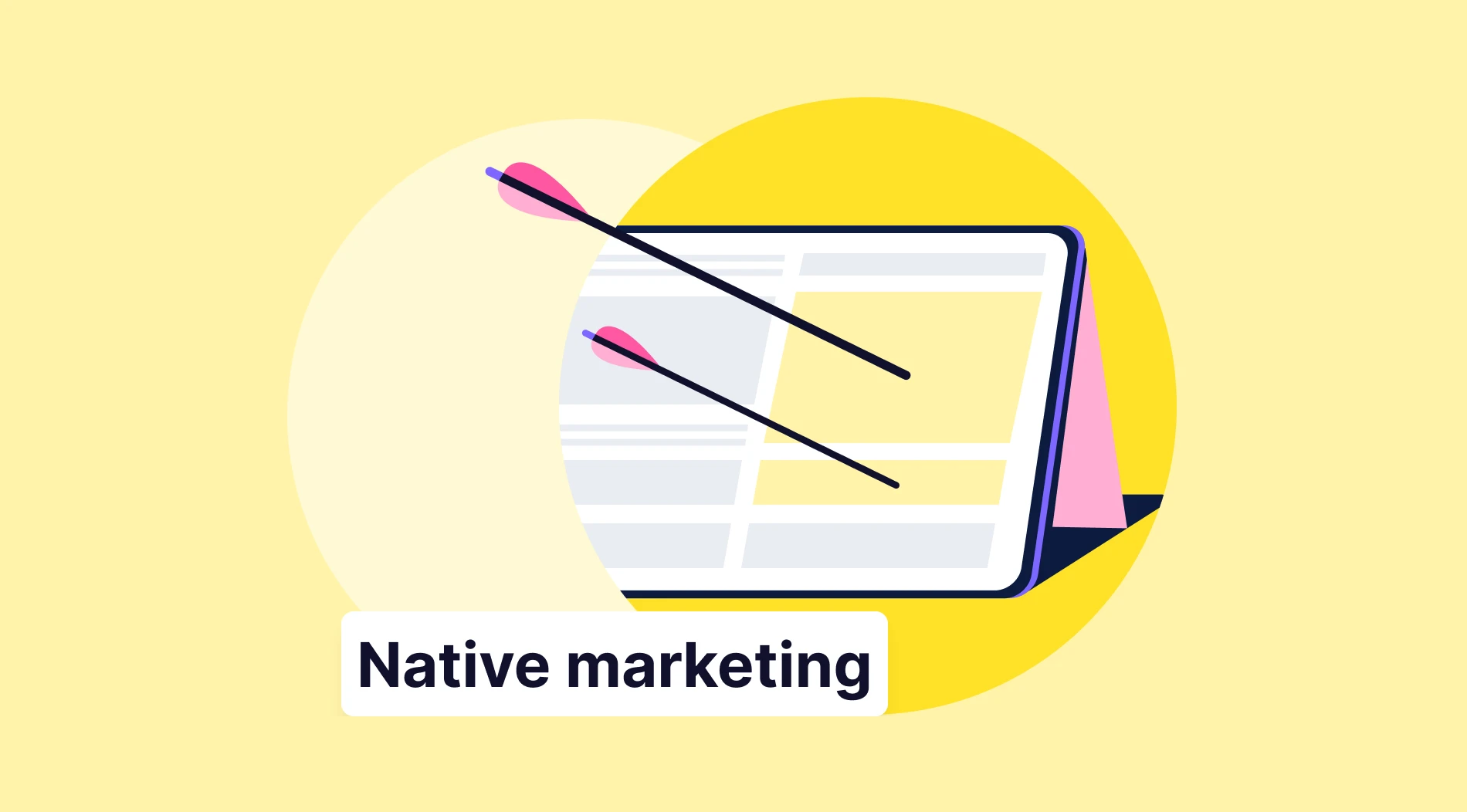
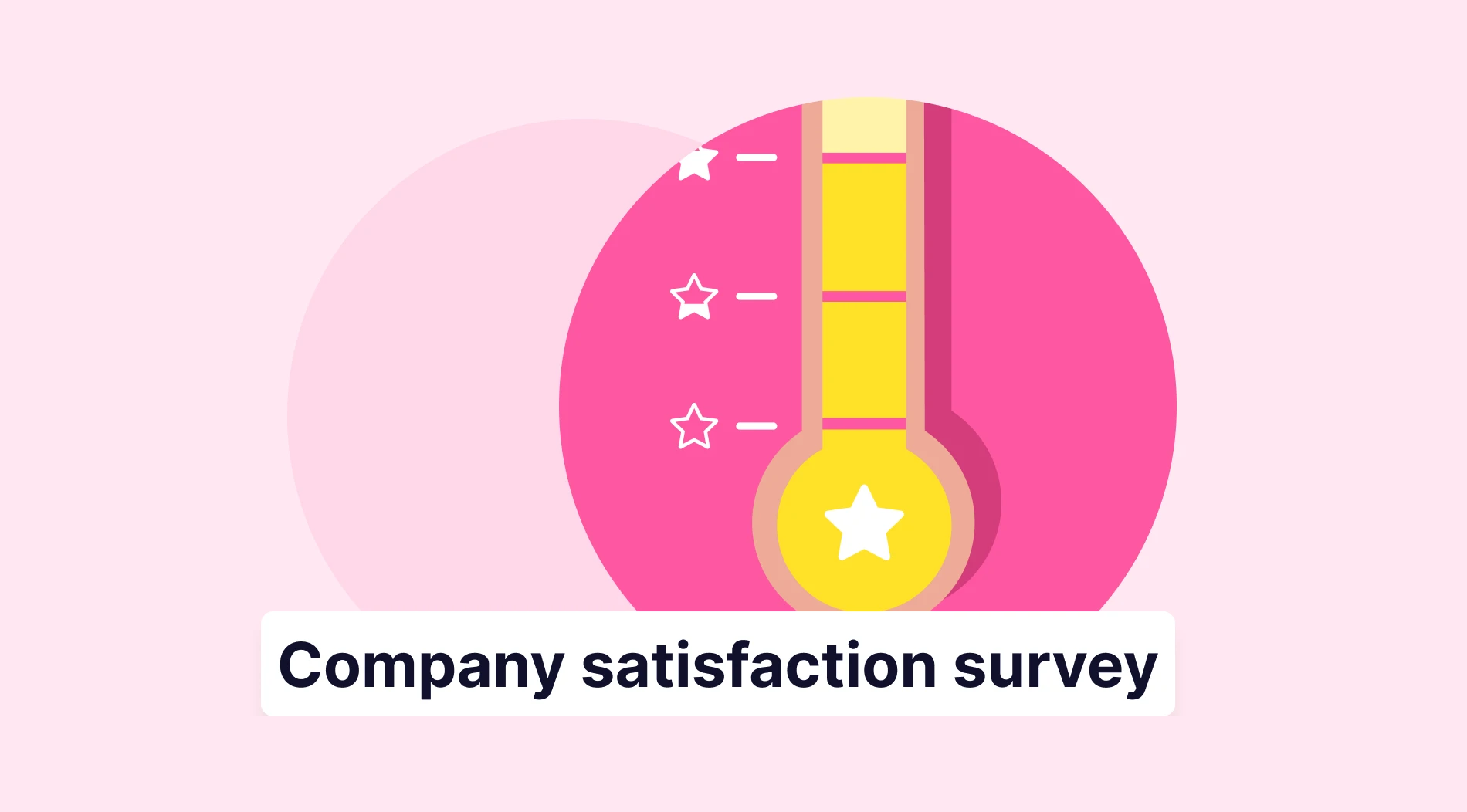
![150+ Fun poll questions for any event [2026 edition]](https://file.forms.app/sitefile/100_fun_multiple_choice_poll_questions_1.webp)